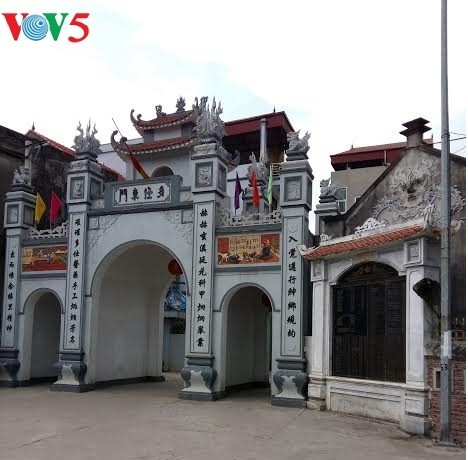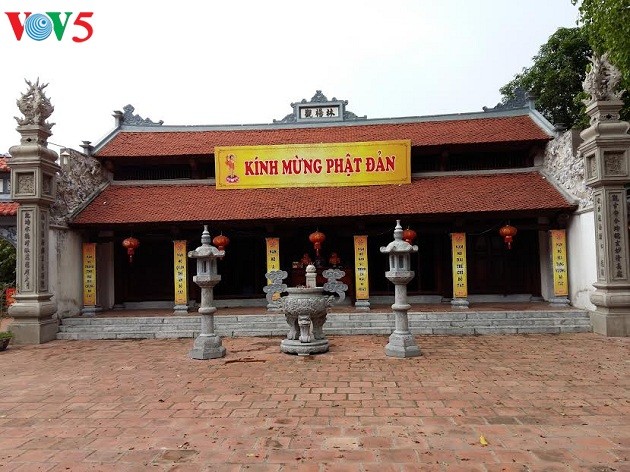(VOVWORLD) - In the previous edition of Village Life, we introduced you to Da Sy village, one of the most famous blacksmith craft villages in the northern delta region. Da Sy is also well-known as the birthplace of many famous physicians, generals, and doctors of the Thang Long Imperial City.
 Da Sy village gate Da Sy village gate |
In the middle of the 18th century, Se village was renamed Dan Khe, then Huyen Khe, and finally Da Sy. The village is now a ward of Ha Dong district, Hanoi.
From the Ly Dynasty, which began in 1010, until the Nguyen Dynasty, which ended in 1945, Vietnam had 20 doctoral villages. During this feudal period, a doctoral village was any village which produced 10 or more doctors.
From the 15th century to the 18th century, Da Sy produced 12 doctors, 9 of them from the Hoang clan, including Hoang Nghia Phu who has been recognized by both Vietnam and China as the top doctor.
Trinh Quoc Hoan, a scholar who has studied Da Sy village, recalls: “In 1431, Hoàng Trình Thanh passed a Confucian court exam and become one of Vietnam’s four most famous scholars. At that time, court examinations were held to choose the nation’s top 4 candidates. Later on, these exams were replaced by doctoral exams. Hoang Trinh Thanh’s nephew was Hoang Nghia Phu, who topped the court examination which conferred Vietnam’s highest doctoral title. Phu was sent to China as the King’s envoy. For his talent, Phu was given China’s top doctoral title by the Chinese King, becoming the top doctor in both nations. In the Tran dynasty, Da Sy village was the home of Vu Phuc Thien, a senior mandarin equivalent to a modern Minister of Defense.”
Da Sy villagers are proud of their tradition of learning. During the early days of the village, Hoang Trinh Thanh himself held classes to teach the village children and encourage them to study for the court examinations. This was the only education center in Vietnam under the 15th century Le dynasty. The Annals of Dai Viet record the contributions and career of Doctor Hoang Trinh Thanh, high-ranking mandarin of the early Le Dynasty, laureate, teacher, politician, military advisor, diplomat, culturist, and great poet. In 1462, Doctor Thanh presented 7 proposals to King Le Thanh Tong, who was trying to reform the country. Thanh’s petition focused on popular policies that made people the root of every reform. All his opinions were incorporated into the Hong Duc Code, the legal foundation of feudal Vietnam.
 Da Sy village pagoda Da Sy village pagoda
|
Village elder Nguyen Hong Phan says the village name Da Sy means ‘many doctors’. ‘Da’ means ‘many’ and ‘Sy’ means ‘doctors’.
He explained to VOV: “The village had many names but finally took the name Da Sy. The names of Da Sy’s doctors are carved on the stone steles in the Temple of Literature. Documents signed by feudal kings honoring the village’s learning tradition are still kept in the village temple.”
Da Sy village was the home of the famous physician Hoang Don Hoa, who was born in 1498 and died in 1583. He was the founder of Vietnam’s military medical sector and is now the village’s tutelary god. He inherited several remedies from the great physician and Zen Buddhist monk Tue Tinh, the founder of Vietnamese traditional medicine.
Trinh Quoc Hoan told us: “Hoang Don Hoa left us thousands of precious traditional medical remedies. His student Trinh Don Phac used them as the basis of his medical career. Trinh Don Phac was responsible for the health of the King and his royal family members. Trinh Don Phac’s students Ngo Thi Nham and Luu Hy Thai both passed the doctoral exams. Trinh Don Phac was respected by Emperor Qian Long and the Chinese Qing dynasty for successfully treating the Queen.”
According to village elders, Da Sy village has produced many talented scholars because it is located in the land of four supernatural creatures - the dragon, the phoenix, the tortoise, and the unicorn.